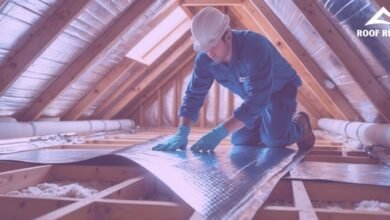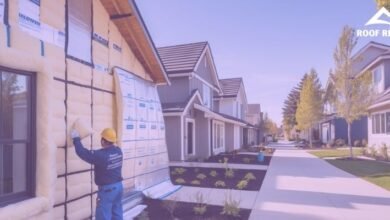What Is a Hip Roof: Design Features and Benefits Explained

When you look up at houses in your neighborhood, you might notice different roof shapes. One common type is the hip roof. A hip roof has slopes on all four sides that come together at the top to form a ridge, creating a simple yet sturdy design that works well in many climates.
Hip roofs stand out from other styles like gable roofs because of their inward slopes on all sides. This design makes them more stable and better able to handle high winds and snow. They can be built in several variations, including simple hip, cross hip, half-hip, and pyramid styles.
Many homeowners choose hip roofs for both their classic look and practical benefits. They provide good space for attics or living areas, and they can be combined with other roof features like dormers or gables to create unique designs. Though they may cost more to build than simpler roofs, their durability often makes them worth the investment.
Key Takeaways
- Hip roofs have slopes on all four sides meeting at the ridge, offering better stability against high winds and heavy snow loads.
- They come in several variations including simple hip, cross hip, pyramid, and half-hip styles that can be adapted to different architectural designs.
- Hip roofs typically cost more to build than gable roofs but provide better durability and weather resistance for long-term value.
What Is a Hip Roof?

A hip roof is a distinctive roof design where all sides slope downward toward the walls with a gentle angle. This popular roofing style offers both practical benefits and aesthetic appeal for many types of buildings.
Key Characteristics of Hip Roofs
Hip roofs have four sloping sides that come together at the top to form a ridge. Unlike other roof styles, there are no vertical ends or flat walls extending to the peak. This design creates a consistent eave line around the entire building.
Hip roofs typically have a pyramid-like appearance when viewed from above. The slopes are usually built at the same angle or pitch, creating a balanced, symmetrical look.
These roofs provide excellent stability in high-wind areas and regions with heavy snowfall. The inward slope of all four sides makes hip roofs more resistant to wind damage than many other roof types.
Most hip roofs include overhanging eaves that help protect the building’s exterior walls from rain and provide shade.
Hip Roof Versus Gable Roof
The main difference between hip and gable roofs is their basic structure. While a hip roof has slopes on all four sides, a gable roof has only two sloping sides that meet at a ridge, creating triangular ends called gables.
Gable roofs are typically easier and less expensive to build than hip roofs. They require fewer materials and have a simpler construction process. However, hip roofs generally offer better stability in severe weather conditions.
Hip roofs provide better protection against strong winds because they don’t have the flat, vertical gable ends that can catch wind. This makes them a popular choice in hurricane-prone regions.
Gable roofs create more attic space and ventilation opportunities, while hip roofs tend to limit usable attic space unless dormers are added.
Basic Structure and Roof Shapes
The basic hip roof structure includes a horizontal ridge board at the top where the roof faces meet. Hip rafters extend from each corner of the building up to the ridge, forming the framework for the sloping edges.
Common hip roof variations include:
- Simple hip roof: Four sides with a single ridge line
- Pyramid hip roof: Four equal triangular sides that meet at a single point
- Half-hip: A combination of hip and gable designs
- Dutch hip: A hip roof with a small gable at the top
Hip roofs can be built with different pitches (slopes). Steeper pitches allow for better water drainage and snow shedding, while lower pitches may be more economical to build.
The framing of a hip roof is more complex than other roof types, requiring careful planning and skilled carpentry to ensure proper load distribution and structural integrity.
Types and Styles of Hip Roofs

Hip roofs come in several distinct variations, each with unique characteristics that affect both appearance and function. These styles offer different aesthetic appeals and practical benefits depending on your home’s architecture and local weather conditions.
Simple Hip Roof
The simple hip roof is the most common hip roof design seen on homes today. It features four sloping sides that come together at the ridge at the top. All sides have an equal slope or pitch, creating a symmetrical appearance.
This design excels in areas with high winds or snow because it lacks gables that can catch wind. The inward slopes provide excellent stability and prevent wind damage.
Simple hip roofs typically require more building materials than gable roofs, making them slightly more expensive. However, they offer better ventilation options and more attic or living space than pyramid designs.
Many colonial, ranch, and craftsman-style homes feature simple hip roofs. They work well with almost any home style and provide a clean, traditional look.
Pyramid Hip Roof
The pyramid hip roof, also called a tented roof, features four equal triangular sides that meet at a single point at the top. Unlike the simple hip roof, it has no ridge line.
This design is especially common on smaller structures like bungalows, cabins, and home additions. You’ll often see pyramid roofs on gazebos, garages, and pool houses too.
Pyramid roofs offer exceptional wind resistance because of their aerodynamic shape. The equal pitch on all sides distributes wind pressure evenly, making them suitable for hurricane-prone regions.
Their symmetrical design creates a striking visual impact. While they provide less attic space than simple hip roofs, they compensate with better durability and weather resistance.
Installation costs tend to be higher because of the more complex framing structure needed to create the perfect pyramid shape.
Mansard Roof
The mansard roof, also known as a French roof, features a unique double-slope design on all four sides. The lower slope is steeper and more vertical, while the upper slope is nearly flat.
This distinctive style originated in 17th century France and became popular in Second Empire architecture. The design maximizes living space by creating usable attic rooms with vertical walls and dormer windows.
Mansard roofs provide excellent flexibility for future expansion. Homeowners can easily add windows through dormers to bring natural light into the upper floor.
Though visually striking, mansard roofs require careful waterproofing on the nearly-flat upper portion. They also demand more maintenance than simpler designs.
These roofs work beautifully on Victorian-style homes, urban townhouses, and buildings with a historical aesthetic. Their elegant appearance adds sophistication and Old World charm.
Dutch Gable
The Dutch gable (also called a half-hip) combines elements of both hip and gable roof designs. It features a small gable at the peak of a hip roof, creating a hybrid structure.
This combination offers the best of both worlds: the stability of a hip roof with the additional attic space and ventilation of a gable. The small gable section often includes a window for natural light.
Dutch gables provide improved airflow to the attic, helping to regulate temperature and reduce moisture buildup. This design also creates more visual interest than a standard hip roof.
These roofs appear frequently on Dutch Colonial, Cape Cod, and some Craftsman-style homes. Their distinctive silhouette makes them immediately recognizable.
While more complex to build than simple hip roofs, Dutch gables offer practical benefits that often justify the additional construction cost.
Design Considerations and Functionality
When planning a hip roof, several key factors influence both performance and appearance. The right design choices ensure your hip roof not only looks attractive but also functions effectively in your specific climate and complements your home’s architecture.
Roof Slope and Pitch
The slope or pitch of a hip roof significantly impacts its performance. In regions with heavy snowfall, steeper pitches (typically 6:12 or higher) help snow slide off more easily, preventing dangerous accumulation and potential structural damage. For hurricane-prone areas, a moderate pitch between 4:12 and 6:12 provides optimal wind resistance.
Climate considerations directly influence pitch decisions:
- Cold climates: Steeper pitches (30-40°) for snow shedding
- Windy regions: Moderate pitches (18-26°) for reduced wind uplift
- Hot climates: Lower pitches with proper overhangs for shade
The pitch also affects interior space usage. Steeper hip roofs can create additional attic space, potentially useful for storage or conversion to living areas.
Ventilation and Drainage
Hip roofs excel at drainage thanks to their sloped design on all sides. Water naturally flows downward, reducing the risk of pooling and leaks. Proper drainage requires correctly sized and positioned gutters along all eaves.
Ventilation is crucial for hip roof performance. Well-designed ventilation systems include:
- Ridge vents at the peak
- Soffit vents under the eaves
- Hip vents along the hip ridges
Good ventilation prevents moisture buildup that can lead to mold, rot, and reduced insulation effectiveness. In summer, proper airflow helps expel hot air, potentially reducing cooling costs by 10-15%.
Aesthetic Appeal
Hip roofs offer classic, balanced aesthetics that complement many architectural styles. Their symmetrical appearance creates visual harmony and often increases curb appeal.
Design elements that enhance hip roof aesthetics include:
- Dormers that add visual interest and natural light
- Overhangs that create appealing shadow lines
- Quality roofing materials like architectural shingles or slate
Color choices matter too. Darker shades often make a home appear more grounded, while lighter colors can make it seem larger and more prominent.
Hip roofs work particularly well with Colonial, French-inspired, and Prairie-style homes. The clean, balanced lines create a timeless look that rarely goes out of style, potentially contributing to long-term property value.
Practical Benefits and Maintenance
Hip roofs provide homeowners with significant advantages in durability and structural integrity. Their unique design features contribute to longevity while requiring specific maintenance approaches to preserve their functionality.
Wind Damage Resistance
Hip roofs excel at withstanding strong winds and severe weather conditions. The inward slope on all four sides creates an aerodynamic profile that allows wind to flow over the structure more easily than other roof types.
During hurricanes or high-wind events, hip roofs experience less uplift force compared to gable roofs. This reduced wind pressure means hip roofs are less likely to suffer catastrophic failure in storms.
The design distributes wind pressure more evenly across the entire roof surface. This balanced distribution prevents the concentration of force that can damage or destroy other roof styles.
Insurance companies often offer lower premiums for homes with hip roofs in wind-prone areas, recognizing their superior performance during extreme weather events.
Self-Bracing Properties
Hip roofs feature a naturally stable design where all sides slope inward to meet at the ridge. This configuration creates a self-bracing structure that provides exceptional stability.
The triangular sides of a hip roof work together to support each other, distributing weight evenly across the entire structure. This weight distribution prevents weak points that could lead to structural failures.
Unlike gable roofs which have vulnerable end walls, hip roofs have no flat, exposed surfaces that can collapse under pressure. Every surface reinforces the others, creating a unified system.
The self-bracing quality means hip roofs can support heavier roofing materials like slate or clay tiles without requiring additional structural reinforcement. This versatility expands design options for homeowners.
Maintenance Needs
Hip roofs can last up to 50 years with proper care and high-quality materials. Regular maintenance is essential to prevent water damage and preserve structural integrity.
Key maintenance tasks include:
- Inspecting and cleaning gutters quarterly
- Checking for loose or damaged shingles twice yearly
- Examining valleys and hip ridges for signs of wear
- Ensuring proper attic ventilation to prevent moisture buildup
Water can pool where roof planes meet, making these areas vulnerable to leaks. Special attention should be given to hip ridges during inspections.
Professional roof inspections are recommended every 2-3 years. These evaluations can identify minor issues before they develop into major problems requiring costly repairs.
Incorporation of Dormers
Dormers integrate beautifully with hip roofs, providing additional living space and natural light in upper levels. They can be designed with their own small hip roofs to maintain the architectural consistency.
Hip roof dormers complement the main roof’s aesthetic while offering practical benefits. These additions create usable space in what might otherwise be attic area with limited headroom.
The additional windows dormers provide improve ventilation throughout the upper floor. This improved airflow can reduce cooling costs during summer months.
When properly constructed, dormers on hip roofs maintain the wind-resistant qualities of the original design. The key is ensuring proper flashing and sealing where dormers join the main roof to prevent water intrusion.
Frequently Asked Questions
Hip roofs have distinct characteristics that set them apart from other roof styles. These roofs offer specific advantages in terms of structure, cost, and environmental performance that homeowners should understand before making roofing decisions.
What are the distinguishing features of a hip roof compared to other roof types?
A hip roof has four sloping sides that all incline downward toward the walls. Unlike gable roofs which have only two sloping sides, hip roofs don’t have flat vertical ends.
The slopes on a hip roof can meet at a ridge at the top or converge at a single point, creating a pyramid-like shape. This design gives the home a symmetrical and balanced appearance.
Hip roofs also feature eaves that extend beyond the walls on all sides of the building, providing additional protection from the elements.
How can one identify a hip roof by its structure and design?
A hip roof is easily identified by its lack of flat, vertical end walls. All sides slope downward toward the walls at similar angles, typically between 18.5 and 26.5 degrees.
In a simple hip roof, two sides form polygon-shaped slopes while the other two have triangular slopes. These four sides come together at the top to create a ridge line.
The corners where adjacent roof slopes meet are called “hips,” which is where this roof style gets its name.
What are the structural advantages of opting for a hip roof on a residential property?
Hip roofs offer excellent stability due to their self-bracing design. The inward slope of all four sides creates a naturally sturdy structure that doesn’t require as much additional bracing.
The design evenly distributes pressure across the structure, making hip roofs particularly resistant to high winds and heavy snow loads. This makes them ideal for homes in storm-prone regions.
These roofs also provide additional living or storage space through the possibility of creating attic rooms or dormers.
In what ways does a hip roof construction impact cost compared to a gable roof?
Hip roofs typically cost more to build than gable roofs because they have a more complex design. The additional slopes require more building materials and more intricate framing work.
The construction process demands more skilled labor and time, which increases overall costs. Roofers need to create more hip joints and valleys, requiring precise measurements and cuts.
However, the long-term savings from increased durability and potential energy efficiency can offset the higher initial investment over the roof’s lifetime.
What should be considered when choosing between a hip roof and a valley roof for a new building?
Climate should be a primary consideration, as hip roofs perform better in high-wind areas due to their aerodynamic shape. Valley roofs may collect more debris and water in rainy regions.
Architectural style plays an important role, as hip roofs complement certain home designs like Colonial, French, or Ranch styles. Valley roofs may better suit other architectural preferences.
Budget constraints matter since hip roofs generally cost more to build and maintain than simpler roof designs. The complexity of the building’s footprint will also impact the final cost.
How does the performance of a hip roof stand up to various environmental conditions?
Hip roofs excel in high-wind environments because their aerodynamic shape allows wind to flow over them more easily than flat or gable roofs. This reduces the risk of damage during storms.
In snowy regions, hip roofs perform well because their slope allows snow to slide off rather than accumulate. This prevents excessive weight buildup that could damage the structure.
However, in extremely rainy areas, proper gutter systems are essential for hip roofs to effectively channel water away from the foundation. The multiple slopes create more runoff that must be managed.




